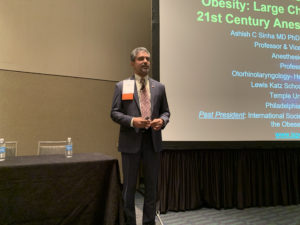Obesity is far too common in the United States. Predictably, morbid obesity – even ultra-obesity – is steadily becoming a regular health care challenge for patients and their physicians. For anesthesiologists, the challenge is driving new, creative ways to care for patients.

Ashish C. Sinha, M.D., M.B.A., Ph.D.
Sunday’s session “Morbid, Super Morbid and Ultra Obesity: Large Challenge of the 21st Century Anesthesia Practice” spotlighted many of those challenges and “ways to get around it,” according to session presenter Ashish C. Sinha, M.D., M.B.A., Ph.D., a Professor and Vice Chairman of Anesthesiology at Temple University Lewis Katz School of Medicine.
“I met my first patient who was morbidly obese, and I probably shouldn’t have said anything, but I asked him about his weight,” Dr. Sinha said. “He responded, ‘My family loves me. They feed me,’ to which I told him his family was feeding him to death.”
Morbid and ultra-obesity can be the curse of dealing with anesthesia in the 21st century, Dr. Sinha said. This epidemic – called globesity – is still rising in the developed and developing world. Unfortunately, safe anesthetic management of a patient with a BMI in the 60s and 70s can be both error-prone and stress-provoking. In fact, some health care providers have policies that restrict patients of a certain weight from being accepted for surgery, according to Dr. Sinha.
Not surprisingly, the epidemic leads to serious health conditions, such as heart attack, stroke and diabetes. Diabetes rates have nearly doubled in the past 20 years, from 5.5% to 9.3%. More than 29 million American adults have diabetes and another 86 million have pre-diabetes. The CDC predicts that one in three adults could have diabetes by 2050.
After smoking, which causes an estimated 430,000 deaths annually, weight-related conditions are the second leading cause of death in the U.S., resulting in about 300,000 preventable deaths each year.
Given such staggering statistics, it’s hard to ignore the obvious when evaluating reasons for increasing girth, Dr. Sinha said. Just look at what is confronting Americans. The food industry produces 3,800 calories a day for every person in the U.S. (2,200 to 2,500 calories would be adequate). This is a 500-calorie-a-day increase since 1970. The American weight spike in the late 1970s corresponded with the invention of super-sizing in fast-food marketing, he said.
Add to that the introduction of high-fructose corn syrup – in almost everything – and bold marketing campaigns that promote “killer” meal names and challenges, such as being rewarded for eating the “heart-attack” burger and other unhealthy foods. Sadly, food marketing campaigns start early, targeting children as young as 2 years of age.
“Are these meals for King Kong? Who needs that much fat?” he asked.
As a result, an individual’s weight problem has become the anesthesiologist’s problem.
“For the first time in the history of humanity, more people are malnourished by being overweight than underweight,” Dr. Sinha said. “The increasing size of patients creates many problems that can be addressed by having a logical and safe approach to these patients. It is hard to not worry when you see a 500 pound patient on your schedule.”
Dr. Sinha discussed a number of challenges beyond the epidemiological factors that contribute to obesity. Such challenges include simple things like getting a blood pressure cup to fit and accessing the right operating table, positioning, and composing a safe approach to the airway as well as the physiologic and pharmacologic issues in drug dosing in this population.
Positioning, for example, may require special tables (or two tables together), making sure the patient is well-strapped to avoid falling off the table, using a bean bag if possible and protecting against pressure areas, such as brachial plexus injuries and sciatic nerve damage.
“Now we get to the fun part,” Dr. Sinha said about the challenge of induction and intubation. Preparation is key. Dr. Sinha introduced attendees to “Sinha’s Aintree technique.” This approach to airway management in morbidly obese patients with cervical instability uses awake insertion of a supraglottic device and Aintree intubation catheter.
While the challenges of operating on a patient who is morbidly obese can be daunting, Dr. Sinha said it can be done. He provided a number of case studies, such as a 38-year-old female scheduled for a colostomy takedown and open gastric banding, with a history of colon cancer, past colostomy and weighing 550 pounds. She had a BMI of 91. Dr. Sinha’s plan to treat the patient involved doubling I.V. access, sitting the patient up and placing an epidural for postoperative pain control and rapid sequence induction with cricoid pressure.
“If approached diligently, most large patients can be safely anesthetized,” he said. “My first ultra-morbid patient did well during surgery and anesthesia, by luck more than anything else. I decided to develop expertise in the management of these patients and share it with colleagues who may feel the same way.”
Return to Archive Index